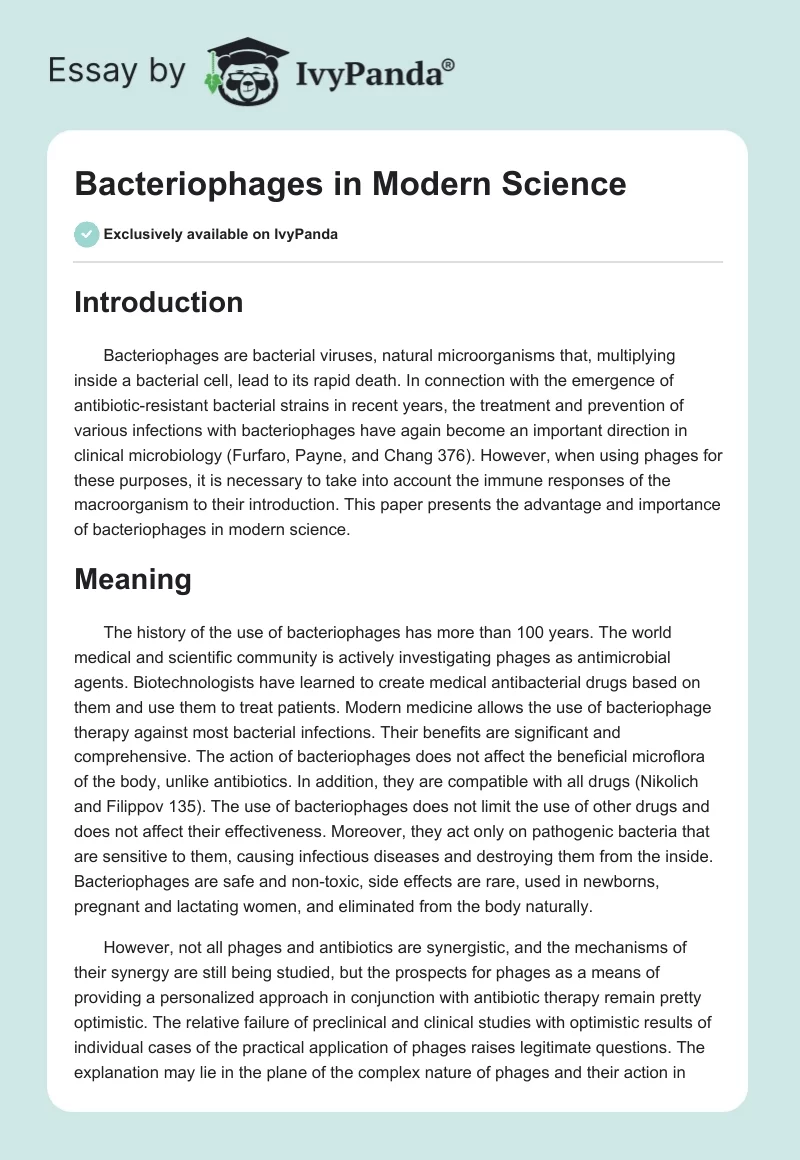Introduction
Bacteriophages are bacterial viruses, natural microorganisms that, multiplying inside a bacterial cell, lead to its rapid death. In connection with the emergence of antibiotic-resistant bacterial strains in recent years, the treatment and prevention of various infections with bacteriophages have again become an important direction in clinical microbiology (Furfaro, Payne, and Chang 376). However, when using phages for these purposes, it is necessary to take into account the immune responses of the macroorganism to their introduction. This paper presents the advantage and importance of bacteriophages in modern science.
Meaning
The history of the use of bacteriophages has more than 100 years. The world medical and scientific community is actively investigating phages as antimicrobial agents. Biotechnologists have learned to create medical antibacterial drugs based on them and use them to treat patients. Modern medicine allows the use of bacteriophage therapy against most bacterial infections. Their benefits are significant and comprehensive. The action of bacteriophages does not affect the beneficial microflora of the body, unlike antibiotics. In addition, they are compatible with all drugs (Nikolich and Filippov 135). The use of bacteriophages does not limit the use of other drugs and does not affect their effectiveness. Moreover, they act only on pathogenic bacteria that are sensitive to them, causing infectious diseases and destroying them from the inside. Bacteriophages are safe and non-toxic, side effects are rare, used in newborns, pregnant and lactating women, and eliminated from the body naturally.
However, not all phages and antibiotics are synergistic, and the mechanisms of their synergy are still being studied, but the prospects for phages as a means of providing a personalized approach in conjunction with antibiotic therapy remain pretty optimistic. The relative failure of preclinical and clinical studies with optimistic results of individual cases of the practical application of phages raises legitimate questions. The explanation may lie in the plane of the complex nature of phages and their action in natural conditions, which cannot fully reflect the simplified models in clinical studies. It is one of the problems of preclinical studies in many animal models and clinical studies in humans. The effect of phage preparations is often weak or blurry. Moreover, it is pretty challenging to understand the real reason for this: either the dose is low, the drug does not work, or the page is in hibernation mode. However, a standardized treatment and monitoring protocol for phage therapy for adults and children has been approved in Australia (Gordillo Altamirano et al. 160). Although in this case, these are exceptions to the rule: phage therapy has not yet been approved by world regulators. Nevertheless, a considerable number of individual cases of successful use of bacteriophages gives hope that, shortly, it will be possible to develop clinical trial protocols for phage preparations that will make them verifiable and repeatable.
Conclusion
At the same time, its high safety can be singled out as an undoubted strength of phage therapy. For more than a century of use of bacteriophages, both in practice and in clinical studies, no cases of adverse reactions have been recorded that can be considered a significant advantage of phage preparations compared to other antimicrobial agents. There is an aspect that has been noted both in clinical studies and in practice: no adverse effects have been registered during their use and study, which can be considered one of the significant advantages of these drugs compared to other antimicrobial agents.
Works Cited
Furfaro, Lucy L., Matthew S. Payne, and Barbara J. Chang. “Bacteriophage therapy: clinical trials and regulatory hurdles.” Frontiers in Cellular and Infection Microbiology 8 (2018): 376. Web.
Gordillo Altamirano, Fernando, et al. “Bacteriophage-resistant Acinetobacter baumannii are resensitized to antimicrobials.” Nature Microbiology 6.2 (2021): 157-161. Web.
Nikolich, Mikeljon P., and Andrey A. Filippov. “Bacteriophage therapy: developments and directions.” Antibiotics 9.3 (2020): 135. Web.


